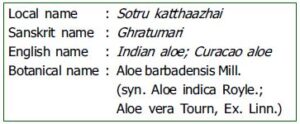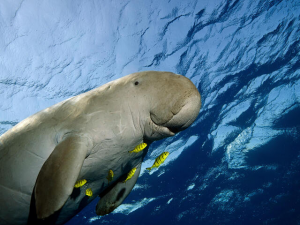The aloe has come to be the most sought after plant for its medicinal qualities. Its therapeutic properties have been known as early as 5000 BC and has been mentioned in the Rig Veda. Every natural cosmetic or medicine, be it a face, body or hair care product, claims to have Aloe vera as a component to enhance its perceived value. Its overexploitation has pushed the plant to an endangered status.

Distribution
It grows wildly in the scrub jungles, slopes and in hedgerows along the drier parts of India. It also grows along the Mediterranean, Canary Island and is natural in Florida, West Indies, and Central America and throughout India and Pakistan.
Description
It is a coarse perennial plant with a short stem and shallow roots. The leaves are fleshy and convex below, with a length ranging from 45 – 60 cms and tapering to a blunt point. The leaves are arranged in radical, rosettes, uniform, succulent and often crowded with thorny prickles on the margins. The leaf surface is pale green with irregular white blotches. The flowers are yellowish orange in color, arranged in a raceme.
Cultivation
It is cultivated and/or propagated by its rhizomes.
It grows in almost all kinds of soils.
Potential value
Aloe barbadensis constitutes the source of an important pharmocopoeia drug aloecutin A (a steroid). The principal constituent of Aloin is a water soluble crystalline glycoside. The other constituents include barbaloin, isobarbaloin, aloe-emodin, sioemodin and resins.
Aloe barbadensis yields aloin (21.8 %), sugars (4.5%), gums (8.2%), resin (5.7%) and amino acids. In addition, the leaves contain sterol, triterpenoids, substantial amount of cholesterol, sitosterol, camesterol and lupeol.
Three kinds of preparations are made from the leaves of the aloe: juice, emulsion and a syrup with iron. Aloes are used to treat a host of diseases, especially associated with the digestive system.
The waxy extract of the aloe is called hepatic or livery aloe and its strong concentration is called glassy or vitreous aloe.

Medicinal importance
Aloe components are used to treat many diseases like uterine disorders, menstrual suppressions, painful inflammation, skin diseases and sterility in women. A hot poultice of leaves gives relief from swellings. The glycoprotein from aloe has anti-inflammatory and anti-cancer properties. Alcoholic extracts of the stem has an anti-bacterial effect and can be used against E. Coli. The juice heated to 80 degree centigrade for 15 minutes is reported to inhibit the growth of many kinds of bacteria.
Economic importance
The
juice of the aloe leaves is used to control termite attack in wooden objects
and mango seedlings. The fibre from the leaves is used for making paper and in
the textile industry.
Status
It
is getting endangered due to loss of habitat and over exploitation for its
medicinal value. In keeping with folklore, people in Tamilnadu hang the whole uprooted
plant in front of the house to avoid bad spirits and evil omens.
M. Amirthalingam
C.P.R. Environmental Education Centre
Source:
Eco News, Vol. 7, No. 2, July – September, 2001.




